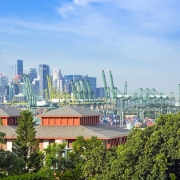New A Level H2 History syllabus
Changes to the GCE A Level H2 History syllabus
From 2017 onwards, the A Level History syllabus has been reviewed and updated. In contrast to the previous syllabus, there are some changes to the topics covered in the essay and source-based case study questions. Also, changes to the examination format are made. Therefore, it is important to pay attention to these developments as you gear up for the final examination. In this article, we will be looking at the syllabus requirements for H2 History (9752).
For more information, please refer to the comprehensive document provided by the Singapore Examinations and Assessment Board (SEAB): H2 History Syllabus for 2020; H2 History Syllabus for 2021
1. Format of Assessment
For the examination format, the H2 History (9752) syllabus features two papers:
- Paper 1: Shaping the International Order (1945-2000)
- Paper 2: The Making of Independent Southeast Asia (Independence-2000)
Students are required to sit for two separate papers (dates are usually announced in the first few months of the examination year). Within each paper, there are two key sections: Source-Based Case Study and Essays. Since the format for Paper 1 and Paper 2 is identical, we will be examining the two sections in a paper.
1a. Section A: Source-Based Case Study
The first section features the Source-Based Case Study (SBCS in short). Students are required to analyse six sources and answer two sub-questions. These sources can be in the form of written or visual texts. For example, a press release by the U.S. State Department during the Cold War. Alternatively, the source can be a political cartoon that depicts an issue or individual. You can learn more about visual-based sources in our post.
In total, Section A carries 40 marks, which is 20% of the overall weighting.
For the part (a) question, students must compare two sources and answer in the context of the question. It carries ten marks.
Compare and contrast the evidence provided in Sources A and B about Reagan’s motivations behind the Strategic Defense Initiative. [10]
example of the part (a) question
For the part (b) question, students must study all six sources and test the given assertion. This part carries 30 marks.
How far do Sources A-F support the assertion that the Cold War ended mainly because of Reagan? [30]
example of the part (b) Question
1b. Section B: Essays
The second section features the essays. Students are required to answer two questions from Section B.
They have to select 1 out of 2 essay questions in the first set (Paper 1 – Theme II; Paper 2 – Theme I). Then, students must do the same by selecting 1 out of 2 essay questions in the other set (Paper 1 – Theme III; Paper 2 – Theme II).
Within the Section B itself, there will be the ‘EITHER‘ and ‘OR‘ stated clearly to show the available choices for students to pick their preferred choice of question to attempt.
Each essay question carries 30 marks. Therefore, the total marks for Section B is 60 marks, which is 30% of the overall weighting.
How far was the United Nations able to overcome the challenge of Cold War rivalry?
Example of the section b essay question
One important point to remember is that for the Paper 2 Section B, students must compare at least three countries as case studies when supporting their arguments.
2. Syllabus Content
Now that we have examined the examination format, we will now move on to the areas of study for H2 History (9752). Given the broad coverage of content, this article will provide a brief summary of the topics tested for A Level.
2a. Paper 1: Shaping the International Order (1945-2000)
For Paper 1 (which is formerly known as ‘International History’), there are three major themes covered:
- Theme I: Understanding the Cold War (1945-1991) [SBCS]
- Theme II: Understanding the Global Economy (1945-2000) [Essay]
- Theme III: Safeguarding International Peace and Security [Essay]
For Theme I, students will examine the Cold War topic from a chronological order: starting with its origins, followed by its internationalisation and finally its eventual end. The Cold War topic is an overarching theme that is essential for A Level given its widespread effects not only in Europe, but also in Southeast Asia. This means that your knowledge of the Cold War can be applied to Paper 2 as well.
For Theme II, students will learn more about the Growth and Problems in the Global Economy as well as the Rise of Asian Tigers (South Korea and Taiwan). This topic can be analysed both from the economic and political perspectives. Notably, the establishment of multilateral financial institutions (IMF, World Bank & WTO) still affects the modern world in many ways.
For Theme III, students are required to be familiar with the formation of the United Nations as well as its application in Peacekeeping Operations. Given the ever-changing and ever-expanding functions of the United Nations, the A Level H2 History syllabus will only cover four organs: Security Council, General Assembly, Secretary-General and the International Court of Justice. For UN Reforms, there will be changes to the content coverage, particularly the section about the ‘rise of regionalism and regional organisations’.
2b. Paper 2: The Making of Independent Southeast Asia (Independence-2000)
For Paper 1, there are three main themes as well:
- Theme I: Search for Political Stability [Essay]
- Theme II: Economic Development after Independence [Essay]
- Theme III: Regional Conflicts and Co-operation [SBCS]
For Theme I, students will learn about the Approaches to Governance and the Approaches to National Unity. This theme will provide a historical study on how various Southeast Asian colonies (as well as Thailand) became independent after World War Two. Political concepts, such as ‘Parliamentary Democracy’ and ‘Authoritarianism’ will be covered as well.
For Theme II, students are required to learn about the Paths to Economic Development and the Asian Financial Crisis. Similar to Paper 1 Theme II (Global Economy), the application of general economic concepts is carried out to understand how Southeast Asian nations became prosperous. Additionally, there will be a section dedicated to understand the causes and consequences of the 1997 financial crisis.
For Theme III, students are expected to be familiar with Inter-state Tensions and Co-operation as well as the establishment of the ASEAN. This theme is largely relevant in raising awareness on the political complexities of inter-state relations, given the persistence of such challenges in the modern world (e.g. South China Sea dispute). Furthermore, students will learn how this newly-formed regional organisation strives to maintain regional peace and security through various methods.
You can sign up for our JC History Tuition to study productively. Our programme features summary notes, essay outline references and source-based case study practice questions. Our structured curriculum will ensure that your time is well-spent as you learn in a progressive way.
The H2 and H1 History Tuition feature online discussion and writing practices to enhance your knowledge application skills. Get useful study notes and clarify your doubts on the subject with the tutor. You can also follow our Telegram Channel to get useful updates.
We have other JC tuition classes, such as JC Math Tuition and JC Chemistry Tuition. For Secondary Tuition, we provide Secondary English Tuition, Secondary Math tuition, Secondary Chemistry Tuition, Social Studies Tuition, Geography, History Tuition and Secondary Economics Tuition. For Primary Tuition, we have Primary English, Math and Science Tuition. Call 9658 5789 to find out more.











